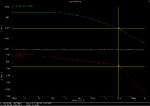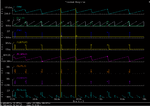naeim29
Newbie level 5

I'm designing a circuit of DC/DC synchronous buck converter for low power application(voltage mode) in 65nm by Cadence tools,I finished the circuit design and it is able to step down 1.1 V to 400 mV(Reference voltage),but its power efficiency is not good(around 35%)I read so many papers to find how i can optimize the power efficiency and I did so many changes for example sizing of switch transistors,changing frequency,changing driver structure...but still its power efficiency is too low!!!in one paper i found that if difference between input voltage and reference voltage is high the efficiency will reduce but I'm not sure how much it will reduce!I will be so appreciated if someone can help me to how I can increase efficiency!thank you so much!
here is my results so far:
Average Input Current : 103.7 uA
Input Voltage: 1.1 v
Average Output Voltage: 399.8 mv
Average Output Current: 99.9 uA
Switching Frequency: 5 MHz
Settling time: 20 usec
voltage ripple: 3.97 mv (0.99%)
current ripple(peak to peak): 993.4 nA (0.99%)
Power efficiency ([Pout/Pin]%): 35%
here is my results so far:
Average Input Current : 103.7 uA
Input Voltage: 1.1 v
Average Output Voltage: 399.8 mv
Average Output Current: 99.9 uA
Switching Frequency: 5 MHz
Settling time: 20 usec
voltage ripple: 3.97 mv (0.99%)
current ripple(peak to peak): 993.4 nA (0.99%)
Power efficiency ([Pout/Pin]%): 35%
Last edited:





